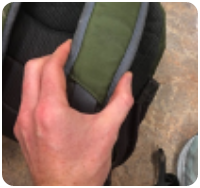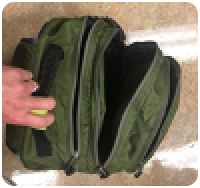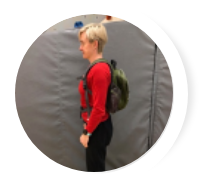Backpacks are becoming increasingly popular and are a staple for many people, including working professionals, athletes, travelers, hikers and, most of all, students.



However, multiple studies have shown that a backpack that is too heavy, poorly packed or worn incorrectly may cause injury, including:
- Back, shoulder and neck pain
- Altered posture and gait
- Musculoskeletal injury risk
- Fatigue
Choosing the right backpack, packing it correctly, and wearing it safely is important for everyone. For people with hemophilia, it may become even more important if target or damaged joints are present. In addition, when you have hemophilia, which impacts the musculoskeletal system, you want to keep that system strong, healthy, injury-free, and balanced.
What To Avoid While Wearing a Backpack
You should NOT need to lean forward, backwards or to the side.
- The force of a heavy weight on your shoulders can pull you backward. To compensate, you might bend forward at the hips or arch your back, creating muscle imbalances and putting more stress on your back.
- People who carry heavy backpacks sometimes lean forward, causing the shoulders to become rounded and the upper back to become curved over time.
- If you wear your backpack over just one shoulder, or carry your books in a messenger bag, you may end up leaning to one side to offset the extra weight, causing pain and bad posture.
Choose Wisely
Backpack should be close to the width of your body or smaller, should sit between your shoulders and your waist, and should have some padding in the back.
Straps of the backpack should be wide and padded.

It should have multiple pockets to help distribute the weight.

If possible, a chest and waist strap are very helpful.
Pack Smart
- Heavier items should be packed in the larger pockets, closest to the core or back, and centre of the backpack.
- Lighter items should be packed in the outer pockets.
- The total load of the pack should be no more than 10 to 15 percent of your body weight.
Quick tips to keep your pack light:
Be thoughtful about what you need that day. Empty out anything extra.
Carry an empty water bottle and fill it when you get to your destination.
For school, try to leave binders at home and just carry some loose paper on a clipboard.
Leave textbooks at home or in your locker.
Wear it Well


Tighten the straps so that the pack sits between your shoulders and waist.
Wear both shoulder straps.
If the backpack has a chest and waist strap, wear them.
By wearing both shoulder straps, you distribute the weight over a larger area. That also relates to wearing a chest and/or waist strap, which allow the weight to be distributed across your rib cage and hips as well as your shoulders.
Packing the weight close to your body allows your core muscles to more easily keep you upright and your spine in a good position.
Personalize Your Pack!
Here are a few ideas for making a “good pack” a bit more personal, stylish, and fun:
- Decorate using fabric markers, puff paints, and a variety of buttons or sequins
- Add patches, logos, or emblems to represent your lifestyle and experiences:
- Countries you have visited
- Concerts you have attended
- Your favourite sports team or music group
- Quotes that inspire you or make you happy
What About Wheels?
If, in spite of these adjustments, carrying a backpack is just too painful or difficult, you can always consider a backpack on wheels. These are commonly seen in professional and travel scenarios. However, backpacks on wheels should be used cautiously and on a limited basis in busy hallways where they can be a tripping hazard.
Hope this information can be helpful in eliminating backpack-related pain and injuries and keep you doing the things you love!

